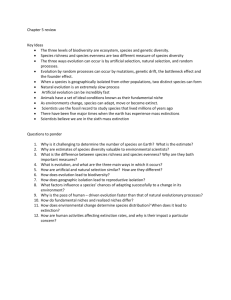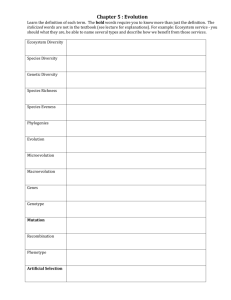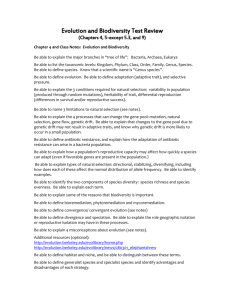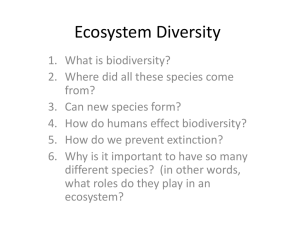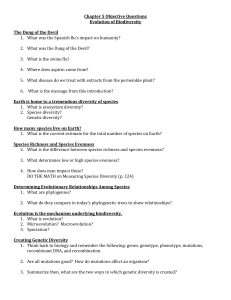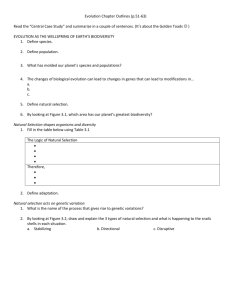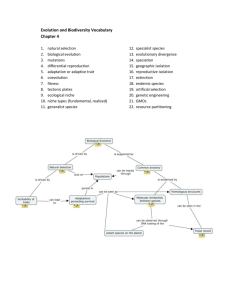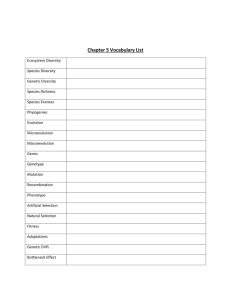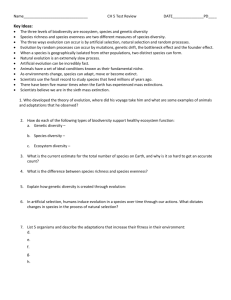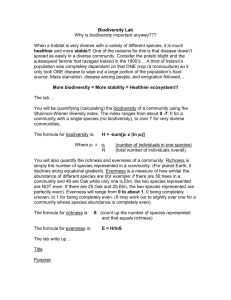Ch. 5 Reading Guide
advertisement
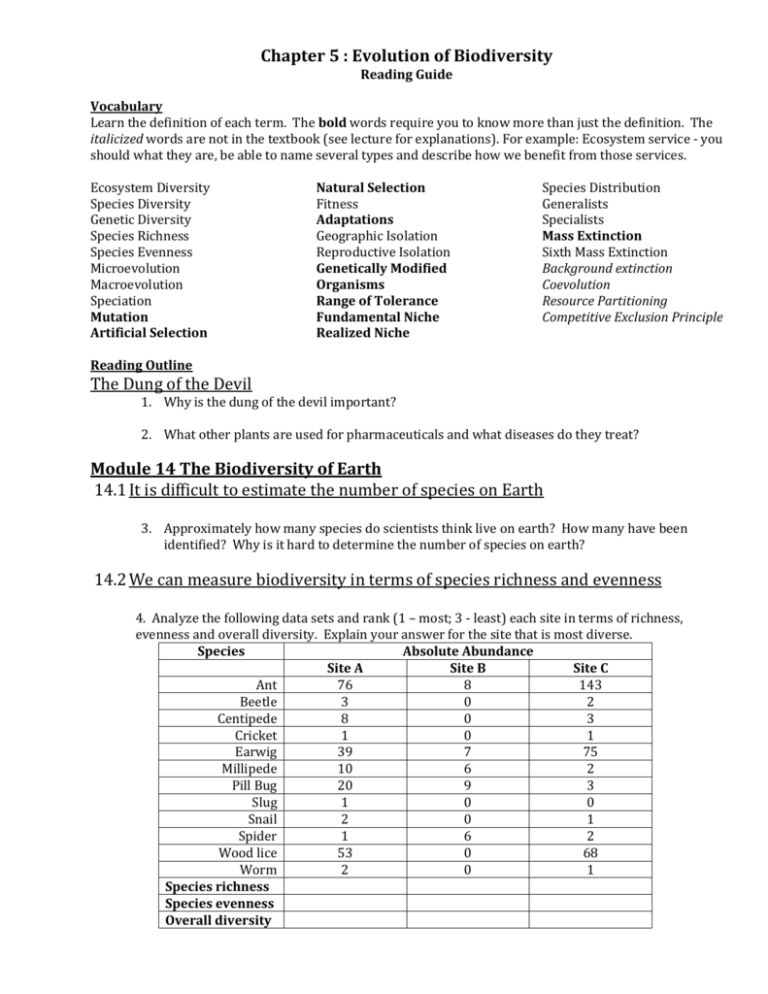
Chapter 5 : Evolution of Biodiversity Reading Guide Vocabulary Learn the definition of each term. The bold words require you to know more than just the definition. The italicized words are not in the textbook (see lecture for explanations). For example: Ecosystem service - you should what they are, be able to name several types and describe how we benefit from those services. Ecosystem Diversity Species Diversity Genetic Diversity Species Richness Species Evenness Microevolution Macroevolution Speciation Mutation Artificial Selection Natural Selection Fitness Adaptations Geographic Isolation Reproductive Isolation Genetically Modified Organisms Range of Tolerance Fundamental Niche Realized Niche Species Distribution Generalists Specialists Mass Extinction Sixth Mass Extinction Background extinction Coevolution Resource Partitioning Competitive Exclusion Principle Reading Outline The Dung of the Devil 1. Why is the dung of the devil important? 2. What other plants are used for pharmaceuticals and what diseases do they treat? Module 14 The Biodiversity of Earth 14.1 It is difficult to estimate the number of species on Earth 3. Approximately how many species do scientists think live on earth? How many have been identified? Why is it hard to determine the number of species on earth? 14.2 We can measure biodiversity in terms of species richness and evenness 4. Analyze the following data sets and rank (1 – most; 3 - least) each site in terms of richness, evenness and overall diversity. Explain your answer for the site that is most diverse. Species Absolute Abundance Site A Site B Site C Ant 76 8 143 Beetle 3 0 2 Centipede 8 0 3 Cricket 1 0 1 Earwig 39 7 75 Millipede 10 6 2 Pill Bug 20 9 3 Slug 1 0 0 Snail 2 0 1 Spider 1 6 2 Wood lice 53 0 68 Worm 2 0 1 Species richness Species evenness Overall diversity 5. In your leaf litter lab, you measured two different forms of diversity: Shannon-Weiner and Simpson. Did the methods favor species richness, species evenness or include both? If you need a reminder of the methods, I put the lab on Edline for you. 14.3 The evolutionary relationship among species can be illustrated using a phylogeny 6. What does a phylogenetic tree illustrate? What are the trees based on? Module 15 How Evolution creates biodiversity 15.1 Genetic Diversity is created through mutation and recombination 7. What are genes? 8. What is the difference between genotype and phenotype? 9. How does mutation affect biodiversity? 10. How does recombination affect biodiversity? 15.2 /15.3 Evolution can occur through artificial selection and natural selection 11. Define natural selection and artificial selection. What is the difference between natural selection and artificial selection? What are some concerns about artificial selection? 12. What are the 5 key elements of Darwin’s Theory of Natural Selection? 15.4 Evolution can also occur through random processes 13. Describe the 5 processes that cause random mutations and give an example of each. Module 16 Speciation and the Pace of Evolution 16.1 Speciation can be allopatric or sympatric 14. What is the difference between allopatric and sympatric speciation 15. Define geographic isolation and reproductive isolation. Describe how each results in speciation. 16.2 The pace of Evolution depends on several factors 16. For each factor, determine which choice supports the claim Factor Species adapt fastest when Populations are most likely to [factor] is survive when [factor] is Rate of FAST or SLOW FAST or SLOW Environmental change Genetic Variation HIGH or LOW HIGH or LOW Population Size LARGE or SMALL LARGE or SMALL Generation Time LONG or SHORT LONG or SHORT 17. Is Genetic engineering faster or slower than natural selection? Explain. Module 17 Evolution of niches and species distributions 17.1 Every species has a niche 18. What is a range of tolerance? 19. What is the difference between a fundamental and a realized niche? 20. What is the difference between a generalist and a specialist? List some characteristics of each. 21. Which type of species (generalist or specialists) do better when: a. Environmental conditions are changing? b. Environmental conditions are stable? 22. Use Figure 17.3 to explain how changing environmental conditions can cause the distribution of species to change. 23. Explain how climate change might impact the distribution of spruce trees. (You have to THINK – look at how the melting of the ice over the last 18,000 years changed the distribution and then apply that information to climate change). Would the range get larger or smaller? Would it be found in more places or less places? Where would the range be in the future? Environmental change can cause species extinctions 24. What differences are there between the 5 previous mass extinctions and the one occurring now? How long does it typically take for biodiversity to “recover” after a mass extinction? Additional Work: Answer the MC questions and FRQ #2. I recommend watching the following video to help you with the FRQ: http://www.pbs.org/wgbh/evolution/educators/teachstuds/svideos.html Video #6: Why does Evolution Matter Now.
